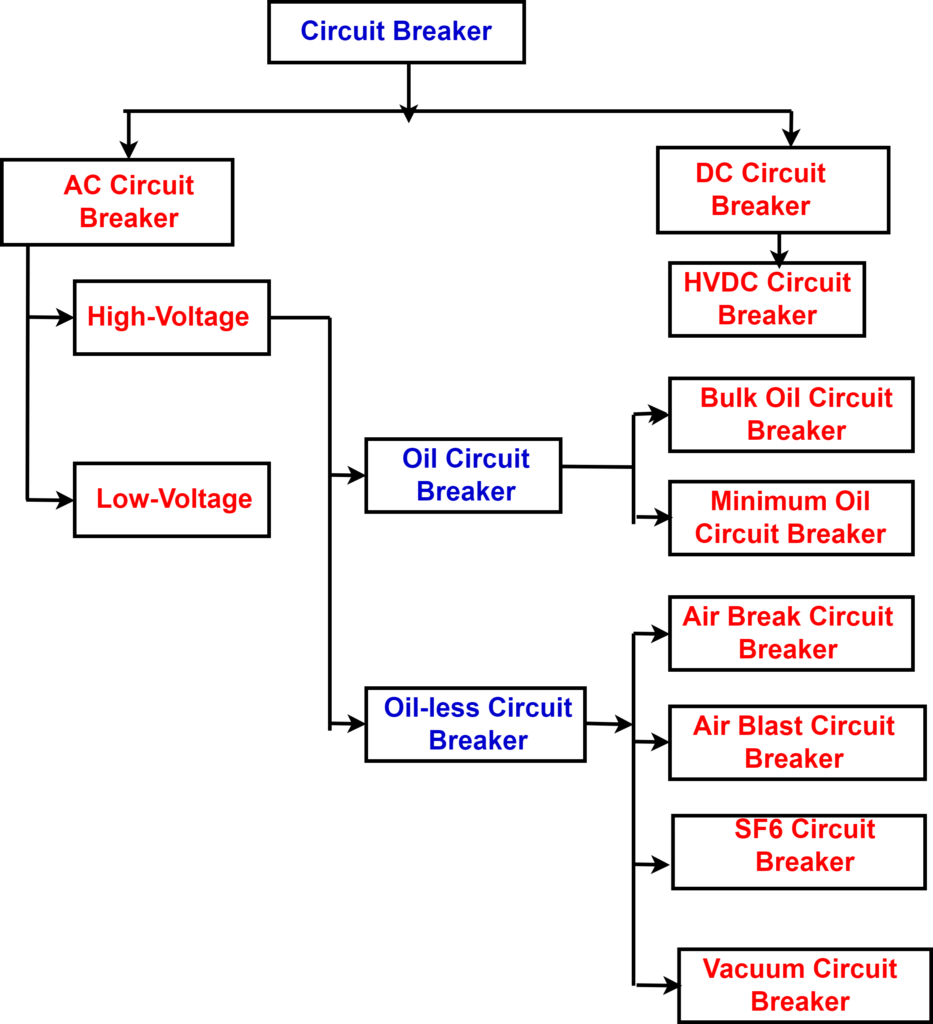There are multiple ways of classification of circuit breakers. Circuit breakers can be classified into different types based on the medium used for arc extinction. Different media, like air, oil, gas, vacuum, etc., can quickly extinguish the arc.
There are four types of circuit breakers that are categorized based on the arc extinction medium they use. These types include air break circuit breakers, sulfur hexafluoride circuit breakers, oil circuit breakers, and vacuum circuit breakers. The figure below illustrates the classification of the circuit breaker.

The two main types of circuit breakers are AC and DC circuit breakers.
AC Circuit Breaker
There are two types of AC circuit breakers: the low-voltage circuit breaker and the high-voltage circuit breaker. The low-voltage circuit breaker is used for values below 1000V, while the high-voltage circuit breaker is used for values above 1000V. The high-voltage circuit breaker can be classified into oil circuit breakers and oil-less circuit breakers.
Oil Circuit Breaker
The oil circuit breaker uses oil as a medium to extinguish the arc. It is sub-categorized into bulk oil type and minimum oil type circuit breaker.

Bulk Oil Circuit Breaker – The bulk oil circuit breaker employs transformer oil as both an arc extinction medium and an insulator between the two conducting parts of the circuit breaker. The oil circuit breaker is rated from 25MVA at 2.5kV to 5000 MVA at 230kV.
Minimum Oil Circuit Breaker –The minimum oil circuit breaker uses oil to extinguish arcs through a blast action. The primary purpose of the oil in this type of circuit breaker is to interrupt arc formation, and it is not intended to insulate live parts from the earth.
The oil impulse circuit breaker is another type of minimum oil circuit breaker. This circuit breaker uses oil jets produced by a piston pump to extinguish the electric arc. The oil jet is directed between the gaps formed by the circuit breaker’s contacts.
Oil-less Circuit Breaker
The four primary types of oil-less circuit breakers are air, oil, sulfur hexafluoride, and vacuum circuit breakers.
Air Circuit Breaker – Air circuit breakers initiate and extinguish arcs in static air. They are used for low voltage ranges up to 15kV, and their rupturing capacity is 500 MVA. The classification of air break circuit breakers depends on the method used for air breaking. The different types of air break circuit breakers are listed below.

The plain air break circuit breaker has contacts that are shaped like horns. In contrast, the magnetic blow type breaker uses a magnetic field to interrupt arcs, while arc-chute circuit breakers are used for low and medium-voltage circuit arc interruption.
Air Blast Circuit Breaker – An air blast circuit breaker uses compressed air to extinguish the arc. The air is stored in a tank and released through nozzles to produce a high-velocity jet that blows out the arc.
This type of circuit breaker is designed for indoor use in medium to high-voltage applications. The air blast circuit breaker can handle voltages up to 15 kV and has rupturing capacities of 2500 MVA, making it suitable for low-voltage applications. These breakers are also commonly used in outdoor switchyards for 220 kV lines. The various types of air blast circuit breakers are shown below.

In an axial blast circuit breaker, the air flows along the direction of the arc, whereas in a cross blast circuit breaker, the air flows perpendicular to the arc.
Sulfur Hexa Flouride Circuit Breaker – The SF6 gas is used in sulfur hexafluoride circuit breakers due to its great arc extinguishing property, which is superior to other arc quenching media such as oil or air.
Vacuum Circuit Breaker –This type of circuit breaker features contacts placed within a vacuum interrupter that is permanently sealed. When the contacts separate in the high vacuum, the arc is quenched. These circuit breakers are less bulky, cheaper in cost, require negligible maintenance, and have a long lifespan.
HVDC Circuit Breaker
An HVDC circuit breaker is used to interrupt high-voltage direct current. Its voltage breaking capacity is approximately 33KV, while its current breaking capacity is 2KA.
The main issue with HVDC circuit breakers is that the DC flows in one direction, and the DC system has no zero point. To reduce the fault current to zero, external methods need to be employed. The arc quenching medium for air break circuit breakers can be oil or air blast.